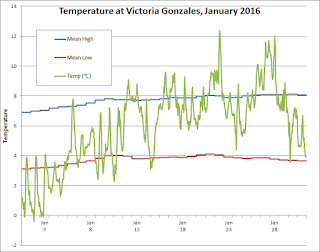We've talked a lot about the current climate in Victoria, mostly using the most recent 30-year average (1981-2010). Today, I'd like to look at the longer term picture. How has the climate changed over time? Luckily, in Victoria we are very well placed to look at long term trends thanks to the very long period of record at the Victoria Gonzales weather site. It's been gathering weather data since 1898 - nearly 118 years - making it the longest such record in B.C. and one of the longest on the west coast of North America.
Let's start by looking at the trend in mean annual temperature - the average of all high and low temperatures for the entire year. In the chart below, the solid red line shows the annual mean temperature for each year from 1899 to 2015, while the dashed blue line is the mean temperature for the entire period - 10.2 degrees. The mean temperature has ranged from 8.6 degrees in 1916, the coolest year, to 11.7 degrees in 2015, the warmest year. Clearly, there is a lot of variability from year to year, which makes it difficult to see the longer term trends.

To make it a little easier to see the longer term changes, the next chart uses a rolling ten-year average. The first point on this chart is the average for 1899-1900, the next point is 1900-1910, and so on. This smooths out the yearly fluctuations and you can start to see the trends. One thing you'll notice is that the temperature appears to have fluctuated between warmer and cooler periods. For example, it was generally much cooler than average in the 1910s and early 1920s. This was followed by a warmer than average period in the 1930s and 1940s. There was generally a cooler period again in the 1960s and 1970s, but then it became much warmer once again in the 1990s and 2000s. One thing to note is that the cooler period in the 1960s and 1970s wasn't as cool as the earlier cool period, while the warmer period in recent decades has been warmer than the last warm period in the 1930s and 1940s. So underlying these decadal fluctuations, there does seem to be an overall longer term warming trend.

This pattern is likely caused at least in part by the Pacific Decadal Oscillation (PDO). This is a long term fluctuation in the temperature of the North Pacific Ocean which also leads to atmospheric changes that affect our weather. In some ways, it is similar to El Nino, but whereas the cycle between El Ninos is usually a few years, the PDO cycle is more like 20-30 years. Over the past century, the PDO was in a cool phase until about 1925, then a warm phase during 1925-47, followed by a cool phase during 1947-77, and then a warm phase during 1977-2007. The chart below shows the PDO Index over this period. You can see that it matches quite closely with the longer term temperature swings we've observed in Victoria.

In order to see the long range trend more clearly, the chart below uses a rolling 30-year average temperature. The first point on this chart is the 1899-1929 average, the second point is the 1900-1930 average, etc. with the last point being 1985-2015. Just as the 10-year rolling average smoothed out the year to year fluctuations, the 30-year rolling average smooths out some of the decadal fluctuations. Now you can see that there has indeed been a long term warming trend, particularly over the past 40 years. During this time, the 30-year average temperature has increased from 9.9 degrees for 1947-77 to 10.7 degrees for 1985-2015, so roughly a 0.8 degree warming. That may not be as much warming as some other locations have experienced - the B.C. coast and the U.S. Pacific Northwest have generally seen less warming from global warming than other regions - but a 0.8 degree increase in a 30-year average temperature is very significant.

Interestingly, the amount of warming has varied quite significantly depending on which month you look at. For example, there has been virtually no change in 30-year average temperatures during both September and December. By contrast, Januarys have become much warmer, rising from a 1949-79 mean of 3.8 degrees to a 1985-2015 mean of 5.7. That 1.9 degree rise over the past 40 years is more than double the increase in the annual temperature. As a result, January has gone from being the coldest month of the year in Victoria to the second coldest, after December.
Another way to examine the warming trend is to look at extreme temperatures. For example, Victoria recorded low temperatures below -10 degrees in 19 winters during the period between 1898 and 1990 - about once every 5 winters. However, the last time Victoria had a temperature below -10 was December 1990, meaning we have now experienced 25 winters in a row without getting down that cold. Even temperatures below freezing are becoming much less common. For the 1949-79 period, there was an average of 19 days each year with overnight lows below 0. For the most recent 30-year period, that has dropped to an average of just 10 days each winter.
We can also look at the trend in annual snowfall as a surrogate for temperature. The chart below shows the trend in 30-year average seasonal snowfall in Victoria. You can see that it peaked in the 1950s and 1960s during the cold phase of the POD, but has declined significantly since then, dropping from more than 35 cm annually down to around 20 cm annually for the most recent 30-year period.

















